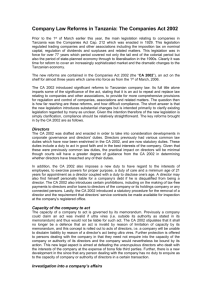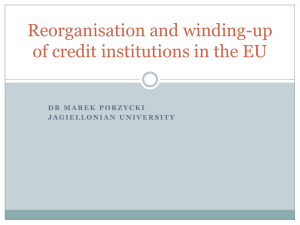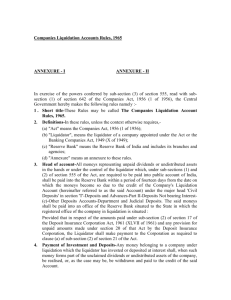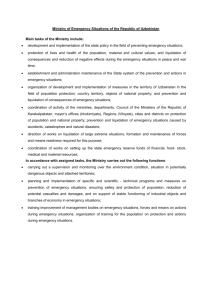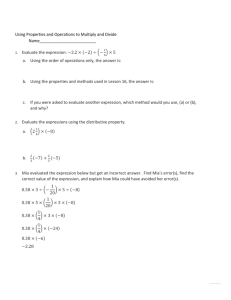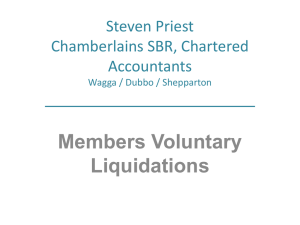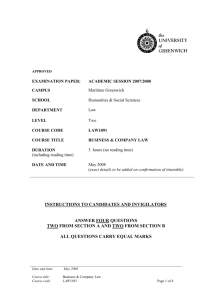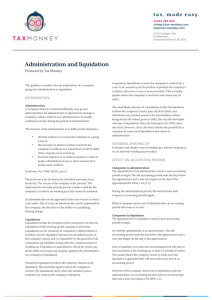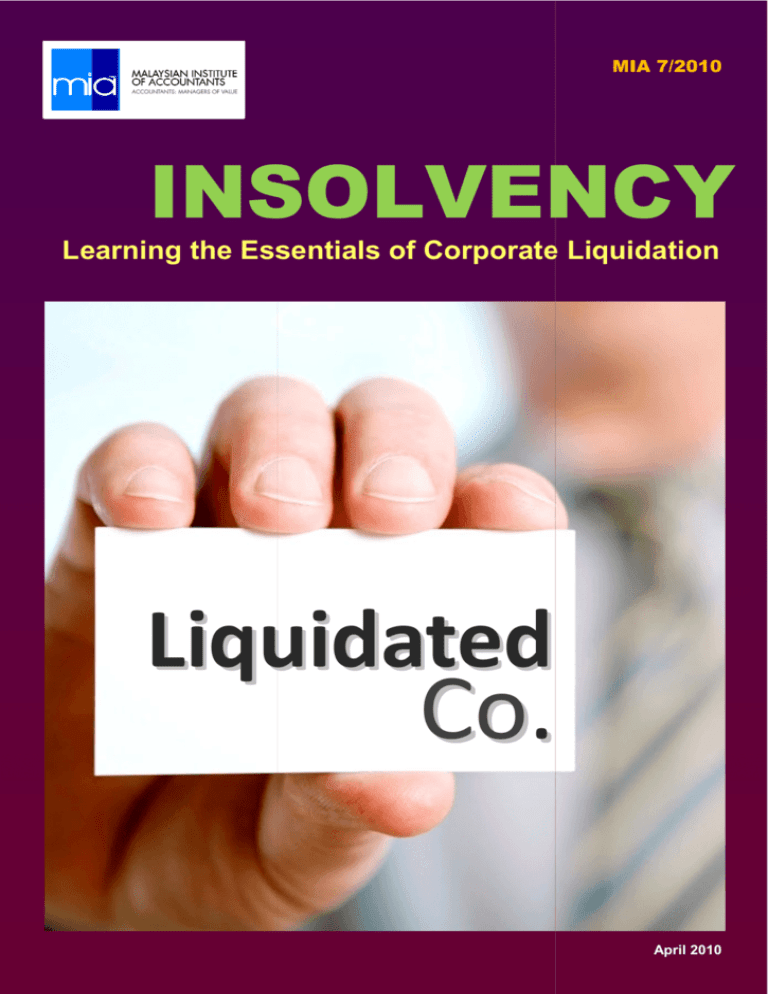
MIA 7/2010
INSOLVENCY
Learning the Essentials of Corporate Liquidation
Liquidated
Co.
April 2010
Copyright © April 2010 by the Malaysian Institute of Accountants (“MIA”). All rights reserved. Permission is granted to make copies of this work provided that such copies are for use in
academic classrooms or for personal use and are not sold or disseminated and provided that each copy bears the following credit line: “Copyright © (Month and Year) by the Malaysian
Institute of Accountants (MIA). All rights reserved. Used with permission of MIA. Contact communications@mia.org.my for permission to reproduce, store or transmit this document.”
Otherwise, written permission from MIA is required to reproduce, store or transmit, or to make other similar uses of, this document, except as permitted by law. Contact
communications@mia.org.my
INTRODUCTION
Economic downturn, rapid market changes, failure of customers to pay overdue accounts or strategic errors — any
of these can plunge a company into serious financial distress. When it becomes apparent that trading cannot
continue, some companies may resort to discontinue or dissolve its operation due to short fall of capital or cutting
down the cost of doing business.
Usually, the directors of the company were responsible upon the dissolution of its company. One of the ways to
dissolve the company is by putting it under winding–up (which is also called as ‘liquidation’).
What is liquidation?
In layman terms, liquidation is the process by which a company is brought to an end, and the assets and property of
the company redistributed. Liquidation is a method whereby the corporate structure of the company is dismantled
and its property administered for the benefit of the creditors and members.
A liquidator (who is normally an accountant who possesses the pre-requisite license) will be appointed to be in
charge of the liquidation process. The liquidator takes full control of the company by collecting and realizing all its
assets, settle all the creditors’ claims and distributes the surplus (if any) to its shareholders in accordance with their
respective rights accorded under Section 292 of Companies Act 1965 (“CA 1965”).
Law Governing
Liquidation Exercise
The law governing liquidation of companies is derived
from statues passed by parliament. Part X of the CA 1965 is
the main regulation that governs liquidation process.
Other related regulations include, amongst others:
•
Companies Winding-Up Rules 1972
•
Bankruptcy Act 1967
•
Sales Tax Act 1972
•
Service Tax Act 1975
1
Modes of Liquidation
There are generally two (2) categories of liquidation:
1 Compulsory Winding-Up
2 Voluntary Winding-Up
(also known as Court-Ordered Winding-Up)
In insolvency
(unable to pay debts)
Members’ Voluntary Liquidation
(“MVL”)
This is a winding-up of an insolvent company
MVL is the liquidation of a solvent company
which is triggered by a court order on the
where the directors must form an opinion
application of one or more parties. Such
that the company will be able to pay its
parties
a
debts in full within a period of twelve (12)
contributory or the personal representatives
months after commencement of winding-up
of a deceased contributory or the trustee in
as stated under Section 257 of CA 1965. To
bankruptcy. This type of winding-up requires
facilitate understanding on the MVL process,
the petitioner to state the grounds of
a checklist is included as Exhibit 1 to this
winding-up as set out in Section 218(1) of CA
publication for reference.
may
include
a
creditor,
1965.
On Other Grounds
Creditors’ Voluntary Liquidation
(“MVL”)
The court has the power to wind up a
CVL
company on grounds other than insolvency.
company where the directors will make a
The court may instruct a company to wind
declaration
up simply because of the breakdown of
cannot by its reason of liabilities continue its
relationship
of
business. Subsequent to that, a meeting of
shareholders even though the company is
the company and its creditors will be
solvent. An application has to be made in
summoned within one (1) month from the
order to wind up the company stating the
date of the declaration. This declaration
grounds for such proceeding in accordance
must be lodged with the Registrar and the
with Section 218 of CA 1965.
Official Receiver (“OR”) as stated under
between
two
groups
is
the
liquidation
stating
that
Section 255 of the CA 1965.
2
of an
the
insolvent
company
Commencement Date of Liquidation
In liquidation, it is important to pay attention to the following dates:
•
date of commencement of winding-up
•
date of winding-up
•
date when the liquidator takes over the affairs of the company
Each date related to winding-up will have different implication towards winding-up company as follows:
1. Voluntary Winding-up
Section 219 of CA 1965 states that the commencement of the winding-up of a company under voluntary
winding-up shall be deemed to have commenced at the time of the passing of the resolution. In other
cases the winding-up shall be deemed to have commenced at the time of the presentation of the petition
of winding-up.
Commencement Date of Liquidation
2. Compulsory Winding-up
The compulsory winding-up will only occur when the court order is obtained. Therefore, the date of the
commencement of winding-up mentioned in Section 219 of CA 1965 will differ from the date that the court
orders the winding-up. Furthermore, the date where the liquidator takes over the affairs of the company
from directors also may be different from the date of the court order winding-up as the liquidator is not
capable of acting as a liquidator unless he has notified his appointment to the Registrar and given security
to the Official Receiver as stated under Section 228 of CA 1965.
Responsibilities and Duties of Directors
Directors’ duties and responsibilities upon the winding-up company include the following:
•
Maintain the affairs of the company until the liquidator takes full possession of the company.
•
Pass all assets including books and records of the company to the liquidator.
•
Ensure that during the transition period all statutory requirements as provided in the CA 1965 are fulfilled, for
instance filing tax returns and maintaining books and accounts.
Effects of Liquidation on Directors
Company’s directors should be fully conversant with the effects of a winding-up prior to their decision to proceed
to pass the special resolution for winding-up. Therefore, the directors should pay more attention on the provisions
stated under the CA 1965 which will affect them most as follows:
•
Section 258(2) – All the powers of the directors shall cease unless the liquidator or the company in a general
meeting with the consent of the liquidator approves the continuance thereof.
•
Section 256(1) – The company, shall from the commencement of the winding-up cease to carry on its
business, except so far as may be necessary for the beneficial winding-up thereof.
•
Section 256(2) – Any transfer of shares, except for transfer made with the sanction of the liquidator and any
alteration in the status of members, made after the commencement of the winding-up, shall be void.
3
Consequences of Liquidation
The modus operandi of a company will inevitably change upon commencement of the winding up process. Some
of the consequences are set out below:
1. Appointment of Provisional Liquidator
The directors should be aware that there is chance where the assets of the company will be dissipated by
irresponsible individual before getting the court decision on winding-up. The appointment of provisional
liquidator will ensure the safeguard of the assets of the company which has been wound up.
The court may appoint the Official Receiver or an approved liquidator provisionally at any time after the
presentation of a winding-up petition and before making of a winding-up order. The provisional liquidator shall
have and may exercise all the functions and power of liquidator subject to limitations as may be provided or
the court may impose.
2. Inadmissibility of debt incurred after the petition
As a general rule, debts or claim arise after the commencement date of winding-up will be rejected by the
liquidator.
3. Legal Action
The directors are not allowed to take any legal action or proceedings against the company once the court
has decided that the company be wound up or where a provisional liquidator is appointed. Section 226(3) of
CA 1965 however empowers the court to allow such action or proceedings to continue with some term that
the court may impose.
4. Restrain Proceedings Against the company
To afford some protection to the company where the assets may be dissipated by creditor continuing to seek
remedies to their claim ahead of other creditors by legal means and to ensure equal distribution of assets, the
court provide that any time after the presentation of a winding-up petition and before a winding-up order has
been made, the company or any creditor or contributory may, where any action or proceedings is pending,
apply to the court to stay or restrain the proceedings on such terms as it thinks fit.
5. Disposition of Assets Void
To ensure there is no improper dispositions of assets between the time of presentation of the winding-up
petition and the winding-up order, any disposition of property of the company, including the transfer of
shares or alteration in the status of the members of the company made after the commencement of the
winding-up by the court shall be void unless the court otherwise orders.
4
Consequences of Liquidation (continued
continued)
6. Undue Preference
To ensure that all creditors are treated equally and there is no preference in making payment to them from
the date of winding-up,
up, CA 1965 provides that any transfer, mortgage, delivery of goods, payment, execution
or other act
ct relating to property made or done by or against a company shall be void or voidable. Pursuant
to the Bankruptcy Act 1967, these transactions are void or voidable over six (6) months before the
commencement of the winding
winding-up (except for bona fide purchaser
er through or under a creditor of the
bankrupt).
7. Failure to submit Statement of Affairs
Directors have the obligation to submit the statement of affairs on time. The statement of affairs of the
company as at the date of winding
winding-up order showing the assets and liabilities and other information as
prescribed must be submitted
tted to the Official Receiver or the liquidator. The statements of affairs should be
submitted by one or two persons who are at the date of the winding
winding-up
up order is a director, company
secretary or liquidator.
Any person (including directors) who without reasonable excuse defaults in comp
complying
lying with this provision shall
be guilty of an offense under the CA 1965. The penalty imposed for non
non-compliance
compliance is imprisonment of three
(3) years or ten thousand ringgit (RM10,000) or both.
8. Declaring Solvency Without Reasonable Grounds
Directors are required
quired to make a written
declaration
after
consideration
and
taking
inquiry
into
to
the
company’s affair that the company will
be able to pay its debts in full without
exceeding twelve (12) month period
after commencement of the winding
windingup. The directors shall
hall be guilty if the
declaration is made without having the
reasonable grounds that the company
will be able to pay debts in full within the
stipulated period. The penalty imposed
for non-compliance
compliance is imprisonment of
three (3) years
ears or ten thousand ringg
ringgit
(RM10,000) or both.
5
Looking for More Insolvency References?
MIA Insolvency Guidance Notes
The Malaysian Institute of Accountants ((“MIA”)) has issued a set of Insolvency Guidance Notes (“IGNs”).
(
These IGNs
serve as a form of best practice and aims to harmonize the approach of insolvency practices.
The IGNs comprise twelve (12) documents which are categorized into three (3) groups as follows:
IGN No.
Preface
Title of IGNs
Preface to Ins
Insolvency Guidance Note
GENERAL
IGN G1
Minimum Standards of Practice for Insolvency Practitioners
IGN G2
Professional Conduct and Ethics in Insolvency Practice
IGN G3
Remuneration of Insolvency Office Holders
IGN G4
Handling of Funds in a Liquidation Administration
IGN G5
Preparation of Statement of Receipts and Payments by Insolvency Practitioners
LIQUIDATION
IGN L1
Members' Voluntary Winding
Winding-Up
IGN L2
Procedures for Creditors’ Voluntary Winding
Winding-up
IGN L3
A Liquidator’s Assessment and Review into the Affairs of an Insolvent Company
IGN L4
Summoning and Holding Meeting of Creditors under Court Winding-up
Winding
RECEIVERSHIP
IGN R1
Suggested Receivership Checklist (for Receiver appointed under a Debenture)
IGN R2
A Receiver's Responsibi
Responsibility
lity for the Books and Records of the Company
IGN R3
A Receiver's Responsibility to Preferential Creditors
A copy of the IGNs can be downloaded at the
Institute’s website at www.mia.org.my/handbook/guide
www.mia.org.my/handbook/guide.
6
Exhibit 1: The Checklist
Checklist for MVL
The checklist on the steps to be taken for winding-up process for Members’ Voluntary Liquidation (MVL) is illustrated
in Exhibit 1 below:
No.
Steps to be Taken
Related
Section of
CA 1965
Prescribed
Form
Action Required
1
To
conduct
Board
Directors’ Meeting.
of
Not Applicable
Not
Applicable
The Board of Directors will have to
determine status of solvency of the
company.
2
To make
Solvency.
of
257
66
The Declaration of Solvency must be
made and signed by at least 2 directors
(majority of them if more than 2) at the
directors’ meeting. It has to be lodged
within 5 weeks with the Registrar before
notice of Extraordinary General Meeting
(EGM) is circulated.
3
To convene an EGM.
254(1)(b) &
258(1)
Not
Applicable
The company’s members at the EGM pass
the special resolution for MVL and also
appoint a liquidator.
4
To lodge notice of special
resolution.
254(2)(a)
11
Notice of Resolution will be lodged to
Registrar within 7 days after the EGM.
5
To advertise
resolution.
254(2)(b)
Not
Applicable
Advertisement on the special resolution
has to be made within 10 days after the
EGM in a newspaper together with the
notice proof of debts requesting creditors
to claims any debts (if any) within 30 days
from the date of notice.
6
To
lodge
notice
of
appointment and situation of
office of liquidator for MVL.
280(1)
71
Notice of appointment and the situation
of office of liquidator need to be lodged
to the Registrar and Official Receiver
within 14 days after the appointment of
Liquidator.
7
To make rubber stamp to
notify that a company is in
liquidation.
283(1)
Not
Applicable
Rubber stamp with the word ‘in
liquidation’ added after the name of
company should be made and to ensure
all the invoices, notices, letterhead and
other relevant documents to the company
should used the same name appeared on
the rubber stamp.
8
To obtain clearance from
relevant
government
agencies such as IRB, EPF,
SOCSO and Customs.
Not Applicable
Not
Applicable
The letters should be sent to the relevant
government authorities to ensure all the
debts incurred with them are settled.
Declaration
the
special
7
Exhibit 1: The Checklist
Checklist for MVL (continued)
continued)
The checklist on the steps to be taken for winding-up process for Members’ Voluntary Liquidation (MVL) is illustrated
in Exhibit 1 below:
No.
Steps to be Taken
Related
Section of
CA 1965
Prescribed
Form
Action Required
9
To prepare the Liquidators’
Statement of Accounts.
281(1)
75
Within 1 month after the expiration of the
period of 6 months of the commencement
date of liquidation and for every
subsequent of 6 months, the liquidator is
required to prepare the Liquidators’
Statement and lodge to Registrar and
Official Receiver.
10
To summon a general
meeting of the company if
the winding-up continues for
more than 1 year.
271
Not
Applicable
The liquidator shall summon a general
meeting at the end of the first year from
the commencement of winding-up and of
each succeeding year or not more than 3
months after the end of the year if the
winding-up is unable to dissolve within a
year.
11
To inform Registrar if any
changes
in
liquidator’s
address.
280(1)
73
Any changes on the liquidator’s address
need to be lodged to Registrar within 14
days after the change.
12
To inform Registrar if any
resignation or removal of
liquidator.
280(3)
74
Any resignation or removal of liquidator
need to be lodged to Registrar and
Official Receiver within 14 days.
13
To placed any unclaimed
dividend or other moneys to
Official Receiver.
286(1)
76 &
Unclaimed
Money
Form
Any unclaimed divided or other moneys
which remained unclaimed for more than
6 months shall be placed to the
Companies Liquidation Account and also
shall obtain a Certificate of Receipts from
the Official Receiver for the amount paid.
14
To convene Final Meeting.
272(2)
Not
Applicable
Advertisement on Notice of Final Meeting
shall be published in a newspaper
circulating generally throughout Malaysia
at least 1 month before the meeting.
272(3)
69
281(1)
8
75
The Return by Liquidator Relating to Final
Meeting together with a copy of the
accounts need to be lodged to Registrar
and Official Receiver within 7 days.
The Liquidators’ Accounts or Statement of
Receipts and Payments need to be lodged
to Registrar within 1 months after the Final
Meeting.
The Malaysian Institute Of Accountants (“MIA”)
MIA is a statutory body established under the Accountants Act, 1967 to regulate and develop
the accountancy profession in Malaysia. To date, MIA has close to 25,000 members. For more
information please visit: www.mia.org.my
The Use of the Word “Accountant”
“Accountant”
In Malaysia, the word “accountant” is protected as provided for under the provisions of the Act
which states that no one can hold himself out or practise as an accountant unless he is
registered as a member of MIA.
DISCLAIMER STATEMENT
Disclaimer
Disclaimer
1. This document contains general information only and MIA is not, by means of this
document, rendering any professional advice or services. This document is not a substitute
for such professional advice or services, nor should it be used as a basis for any decision or
action that may affect your business. Before making any decision or taking any action that
may affect your business, you should consult a professional advisor.
2. Whilst every care has been taken in compiling this document, MIA makes no representations
or warranty (expressed or implied) about the accuracy, suitability, reliability or completeness
of the information for any purpose.
3. MIA, its employees or agents accept no liability to any party for any loss, damage or costs
howsoever arising, whether directly or indirectly from any action or decision taken (or not
taken) as a result of any person relying on or otherwise using this document or arising from
any omission from it.
Dewan Akauntan
No. 2, Jalan Tun Sambanthan 3
Brickfields, 50470 Kuala Lumpur
Malaysia
[phone] +603 2279 9200
[fax] +603 2274 1316
[web] www.mia.org.my
[email] technical@mia.org.my

